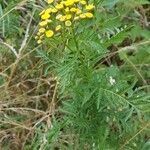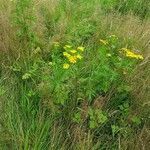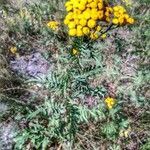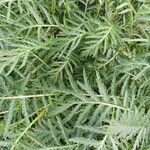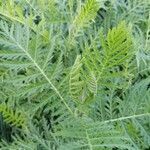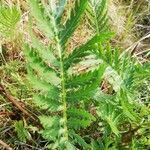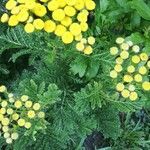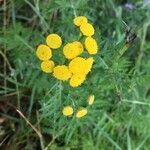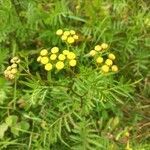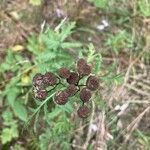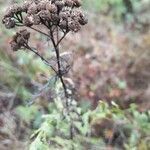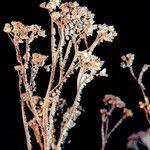Herbs, perennial, 30-150 cm tall, from creeping, ± branched rhizome; stems solitary or clustered, erect, upper part corymbosely branched, usually glabrous. Basal stem leaves petiolate; leaf blade elliptic or elliptic-ovate, ca. 20 × 8-10 cm, 2-pinnatisect, both surfaces green or pale green; primary lateral segments to 12-paired; ultimate segments ovate, obliquely triangular, or narrowly elliptic; middle and upper stem leaves similar, sessile. Synflorescence a ± dense flat-topped panicle. Capitula (5-)10-70(-100), heterogamous, disciform. Involucre campanulate, 5-13 mm in diam.; phyllaries in 3 rows, scarious margin narrow, white or brown, outer phyllaries ovate-lanceolate, ca. 1.5 mm; middle and inner ones lanceolate, 3-4 mm. All florets yellow, tubular; outer ones female, disk florets bisexual; corolla 1.5-2.4 mm. Achenes 1.2-2 mm. Corona 0.1-0.4 mm, margin dentate. Fl. and fr. Jun-Aug. 2n = 18, 18 + 2B.
Perennials, mostly 40–150 cm. Stems 1–2+ (ridged), erect, branched distally (glabrous or sparsely hairy). Leaves basal (soon withering) and cauline; petiolate or sessile; blades broadly oblong or oval to elliptic, 4–20 × 2–10 cm, pinnately lobed (rachises ± winged, primary lobes 4–10 pairs, lance-linear to lanceolate or narrowly elliptic, often pinnately lobed or toothed), ultimate margins dentate, faces glabrous or sparsely hairy, gland-dotted. Heads 20–200 in compact, corymbiform arrays. Involucres 5–10 mm diam. Receptacles convex to conic, epaleate. Ray florets 0 (heads disciform, peripheral pistillate florets ca. 20; corollas yellow, lobes 3–4). Disc corollas 2–3 mm. Cypselae 1–2 mm, 4–5-angled or-ribbed, gland-dotted; pappi coroniform, 0.2–0.4 mm. 2n = 18.
Plants to c. 150 cm high, rhizomatous, transiently pubescent on stems and leaves. Leaves to c. 25 cm long, 1–sub-3-pinnatisect; rachides and ultimate segments c. 1–3 mm wide; primary segments 10–20 per side, variously dissected. Capitula several–numerous per stem, moderately congested, disciform, 5–9 mm diam.; peduncle to c. 5 cm long; involucre 3–5 mm long, slightly cobwebby or glabrous; inner bracts with hyaline extension c. 1 mm long. Marginal florets with corolla 3-lobed, yellow. Disc florets: corolla 1.5 mm long; tube as broad as and as long as limb; limb yellow. Achene of disc florets obovoid, 1.2–1.8 mm long, 5-ribbed, pale brown.
Coarse, aromatic perennial 4–15 dm from a stout rhizome, glabrous or nearly so; lvs numerous, 1–2 dm, nearly half as wide, sessile or short-petiolate, punctate, pinnatifid with evidently winged rachis, the pinnae again pinnatifid or deeply lobed, with broadly winged rachis, the pinnules often again toothed; heads disciform, numerous, commonly 20–200, the disk 5–10 mm wide; 2n=18. Roadsides, fields, and waste places; native of the Old World, established throughout most of the U.S. and adj. Can. Aug.–Oct.
A herb. It grows 90-120 cm high. It spreads 90-120 cm wide. The leaves are divided along the stalk. They look like feathers. The leaves are 12-25 cm long. The leaves are very green and have an aroma and bitter taste. The flowers are bright yellow and occur in clusters. These are about 7 mm wide and the clusters 10 cm wide. They do not have petals.
